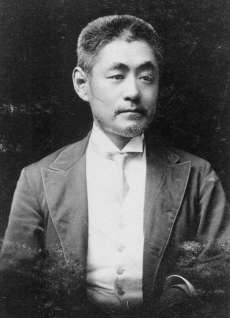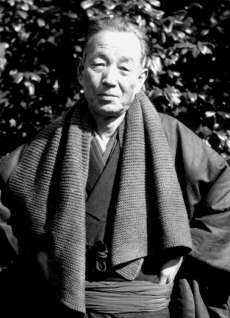FEATURES|COLUMNS|Buddhism in Japan
Expressions between Dogma and Silence: A Japanese Take on the Two Truths
 The Gate of Wisdom (Jap: Tetsurimon) at the Philosophy Garden (Jap: Tetsudōkōen) constructed by Inoue Enryō. Photo by author
The Gate of Wisdom (Jap: Tetsurimon) at the Philosophy Garden (Jap: Tetsudōkōen) constructed by Inoue Enryō. Photo by authorThe doctrine of the two truths is usually assigned to Nāgārjuna (fl. c. 200). In his famous commentary Mūla-madhyamaka-kārikā, he systematically subverts all relevant Buddhist concepts of his time and proposes the doctrine of emptiness. This doctrine proposes that all other doctrines are empty of truth-value. Thus formulated, this doctrine of course raises the question as to what, if anything, is true and can be said. Does the doctrine of emptiness imply quietism or absolutism? In this essay, I will explore how the two Japanese philosophers Inoue Enryō (1858–1919) and Watsuji Tetsurō (1889–1960) interpreted the central Buddhist doctrine of the two truths.
Before I take a closer look at these two 20th-century interpretations of the two truths, I would like to examine how Nāgārjuna and his direct successors defined this concept. In the Mūla-madhyamaka-kārikā, (T 30.1564.32) Nāgārjuna suggests that verbal expressions constitute conventional (Skt: saṃvṛti) truth and their emptiness ultimate (Skt: paramārtha) truth. This doctrine is further expounded in the Śata-śāstra by Nāgārjuna’s disciple Āryadeva (fl. c. 250) and the Chinese Madhyamaka (Ch: Sanlun) thinker Jizang (549–622). The former famously declared that “all buddhas preach the Dharma; they continuously rely on the ‘conventional truth,’” (T30. 1569.181) the latter that “the two truths of conventionality and ultimacy are one yet different.” (T 42.1827.262) Ultimately, however, the doctrine of the two truths is nowhere explained better than by Nāgārjuna himself. He announces in his Mūla-madhyamaka-kārikā that “all things that dependently co-arise, I explain as empty; again, these are provisional designations; again, this is the meaning of the Middle Path.” (T 30.1564.33)
In his investigation of the two truths, Inoue focuses especially on Nāgārjuna’s Mūla-madhyamaka-kārikā and Āryadeva’s Śata-śāstra. Following these texts, he identifies the two truths as the first of the “three essentials;” these are the two truths, the eight negations, and the Middle Way. The two truths consist of the paramārtha and the saṃvṛti truths. The former, to Inoue, explicates the substantial, the latter the contingent. However, to Inoue, the two truths constitute merely the “finger that teaches the moon”* and introduces the “language of religious teachings.”*
A closer analysis of the two truths reveals that the “conventional truth is being,”* the “ultimate truth is emptiness.”* He continues that “being is the provisional designation opposed to emptiness”* and “being is the being of non-being.”* Emptiness, on the other hand, “is the provisional appellation opposed to being,”* it constitutes the “emptiness is emptiness of non-emptiness.”* In short, while “being is the being of emptiness,”* “emptiness is the emptiness of being.”*
To interpret these confounding observations, Inoue offers a heuristic key: he claims that the two truths are “originally non-dual,”* “not two but one.”* In fact they reveal three layers: the layer of “being,” the layer of “being of non-being,” and the layer of “being of emptiness.”* Thus understood, Inoue suggests, the three layers evoked by the two truths illustrate Nāgārjuna’s poem that the products of causal process are empty and indicate the mean.
Interestingly, at this point Inoue postulates a fundamental similarity between the Madhyamaka doctrine of the two truths and Zen teachings. Both heuristic models disclose a threefold structure of affirmation-negation-non-duality. The same structure can, for example, be found in a famous poem from the Transmission of the Lamp, in which an old Zen master recounts that “before I began the study of Zen, I said, mountains are mountains, waters are waters; after I received an insight . . . I said, ‘mountains are not mountains, waters are not waters;’ but now . . . I say, ‘mountains are really mountains, waters are really waters.’” (T 51.2077.614)
 Inoue Enryō. From wikipedia.org
Inoue Enryō. From wikipedia.org Watsuji Tetsurō. From pinterest.com
Watsuji Tetsurō. From pinterest.comSo what is the meaning of the two truths to Inoue? In short, using these two truths, Buddhism overcomes the duality of philosophy and religion. Buddhist philosophy overcomes the duality of “East” and “West.” The conceptual foundation of this “new paradigm” is the Madhyamaka doctrine of the two truths, which anticipates a threefold heuristic model developed further in Zen texts.
Watsuji contends, similarly, that the truth of saṃvṛti conceptualizes “the realm of being”** and the truth of paramārtha “the realm of emptiness;”** paramārtha articulates the “destruction of attachments to being”** while saṃvṛti articulates the “destruction of the attachment to emptiness.” Therefore, the truth of saṃvṛti constitutes Buddha’s “Dharma talk” and not, as frequently and erroneously assumed, the “standpoint of ‘ordinary people.’”**
But how does Watsuji interpret the Mādhyamaka doctrine of the two truths? First, even his reading of the two truths is rooted in an understanding of the Four Noble Truths and the Buddha’s teaching. Second, like Inoue, Watsuji identifies “being” and “emptiness” as the two realms of existence outlined the two truths. Unlike Inoue, however, he uses the formula from the Heart Sūtra: “Form is emptiness, emptiness is form,” to introduce a complex reading of the two truths against each other and renders two hermeneutical attitudes: one of expression and one of de(con)struction. Notable is his practice of reading the truths against each other: the truth of saṃvṛti is to the truth of paramārthawhat the truth of paramārtha is to the truth of saṃvṛti. Ultimately, Watsuji suggests that the doctrine of the two truths does not outline two separate standpoints of philosophizing but rather two attitudes: one of expression and one of de(con)struction.
What can we learn about the meaning of the Madhayamaka doctrine of the two truths from these two Japanese Buddhist philosophers? Ultimately, all three thinkers discussed seem to conclude that the Madhaymaka doctrine of the two truths suggests “communication without reification.”** In some sense, truth claims are “conventions” (language games?). An adoption of these two truths leads to epistemic humility and what I have called an “ethics of understanding” or “ethics of expression.” As such, I believe, there is ample opportunity to apply the reading of the two truths explored in this essay to various aspects of our thought and actions.
* All quotes by Inoue are taken from IES 5, 135–140.
** All quotes by Watsuji are taken from WTZ 19, 295–303.
References
Inoue enryō senshū (Selected Works of Inoue Enryō). 25 volumes. 1987–2004. Tokyo: Gakkō Hōjin Tōyō Daigaku. [Abbr. IES]
Taishō Taizōkyō (The Taisho Edition of the Buddhist Canon). Edited by Junjirō Takakusu and Kaigyoku Watanabe. 1961. Tokyo: Taishō Shinshū Daizōkyō Kankōkai. [Abbr. T]
Watsuji tetsurō zenshū [The Complete Works of Watsuji Tetsurō]. 21 volumes. 1961–63. Tokyo: Iwanami Shoten. [Abbr. WTZ]
Related features from Buddhistdoor Global
“Many Have Gradually Realized that Buddhism is not a Superstition” – Dr. He Huanhuan Discusses Buddhist Studies in China
Living with Awareness, Practicing with Intent: An Interview with Yongey Mingyur Rinpoche
What it Means to be a Buddhist














